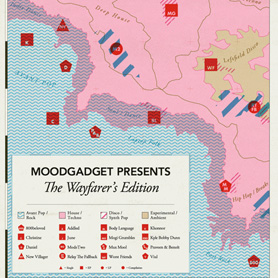Alex Koplin
Creative Consultant of H34DUP and Moodgadget
Primary design concentration:
Bringing ideas to life, regardless of medium, constraint, or prior experience. My skill set includes Print, Web, and Videogame Design, Photography, Video Editing/Production, Music, Copywriting/Editing, Marketing, Strategy, SEO/Web Metrics, etc.
Most preferred tool for designing:
Whatever tool is needed for the task at hand, but usually a notepad/whiteboard and Photoshop.
1. How and why did you choose to become a designer?
I have been dabbling in the art of creative articulation since the third grade, but in recent years I’ve come to grips with the fact that this is my passion. I think it came for me when I spent over a year and a half working for a design consultancy in business development (my formal education encompassed business and psychology, not design), I was so jealous of the work the design team was creating, and I was sort of forced to suppress my creative urges during the day, diverting all that creative energy to other projects, it was like I had a 9–5 and then I would go home and work my 5–9. When I stopped working there, I did a lot of thinking and reading and came to this realization. I am still trying to cement this career change, very little is certain about my future, but I now know that designing, creating, inspiring are what will ultimately give me that sense of satisfaction and accomplishment.
2. Challenges you encounter as a designer and how do you deal with them?
I think that it’s been pretty challenging to position myself as a multi-faceted creative, not just a designer, or a photographer, or a DJ, or a marketing consultant, etc. I see a lot of neatly-packaged job descriptions, often accompanied by a roman numeral to denote seniority, and they make me laugh. When trying to get a stranger’s head around what I bring to the table becomes unnecessarily complex, I try to deal with this by stressing that it’s not all about possessing a specific competency, it’s about understanding what’s going on at the core of that idea or project and being able to quickly obtain the necessary competencies based on that understanding.
3. Your definition of an “elegant solution,” that is, good design?
An elegant solution is one that comes naturally, one that is not forced or overly constrained, and that invites use and enables or empowers. Good design, at its core, is a two-way line of communication, and it’s produced as such from start to finish. If your solution is designed to be a one-way street, chances are you are wasting time and money.
4. From skills to values, what makes a designer successful?
In my opinion, successful designers are the ones who stay in touch with their imagination, their own personal talents and interests, and their passions and goals. Variety is the spice of life, and a good designer can place themselves into any type of situation and learn how to creatively articulate and make an impact.
5. How do you stay motivated and grow personally and professionally as a designer?
I always take a moment to admire the view. I also listen to a lot of music, and constantly explore for new tunes, and try to stay in touch with my sense of color synesthesia (perceiving music as colors or images), which is a big source of inspiration. I let my mind wander whenever I get the free time.
6. For those aspiring to become a designer, whatever the discipline,what is your advice?
Be humble but thick-skinned, constantly elicit feedback and make use of that feedback to improve your skills. Compromise is inevitable, but never compromise more than you are comfortable with. One life lesson that has always resonated came from my 7th grade art teacher, who reminded me that “sometimes an artist needs to step back and take a look at the big picture.”
7. What is your quest in design?
I guess in the grand scheme of things, my quest is to prove to myself that seeing an idea become a reality is simply a matter of imagination and will, not budget or hour. My two dreams in my professional life are to work for a record label (currently in-progress), and to work for a videogame studio, but I also want to try my hand back in the agency world on the other side of the office as a designer. I have a lot of ideas I’d like to see realized—products, music, films, games, and I hope one day to be in a position to share them with the world. My grandfather instilled a constant thirst for knowledge in his family. I would really love to find a coursework that best suits my needs and maximizes my strengths, and I definitely intend to continue my education in the next few years.
Previous: Justin Kemerling | Next: Brianna Sylver

Support this solo initiative
What began as a collection of links has evolved into a comprehensive archive committed to creative culture—offering so far 395 interviews with under-the-radar Artists, Designers & Makers, in addition to 202 write-ups across events, books, movies, more. Free to explore. Free from ads. If you gain a level of motivation, knowledge, even delight, from Design Feast, please support on Patreon. Thanks for your consideration!
Wishing you continual success,
Nate Burgos, Content Creator & Publisher
Comments
There are no comments yet.
Leave Your Comment